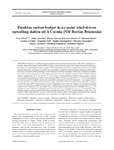Mostrar o rexistro simple do ítem
Plankton carbon budget in a coastal wind-driven upwelling station off A Coruña (NW Iberian Peninsula)
| dc.contributor.author | Teira, Eva | |
| dc.contributor.author | Abalde, Julio | |
| dc.contributor.author | Álvarez-Ossorio, María Teresa | |
| dc.contributor.author | Bode, Antonio | |
| dc.contributor.author | Cariño, Carlos | |
| dc.contributor.author | Cid, Ángeles | |
| dc.contributor.author | Fernández, Emilio | |
| dc.contributor.author | González, Nicolás | |
| dc.contributor.author | Lorenzo, Jorge | |
| dc.contributor.author | Valencia, Joaquín | |
| dc.contributor.author | Varela, Manuel | |
| dc.date.accessioned | 2016-07-28T17:19:09Z | |
| dc.date.available | 2016-07-28T17:19:09Z | |
| dc.date.issued | 2003 | |
| dc.identifier.citation | Teira E, Abalde J, Álvarez-Ossorio MT, Bode A, Cariño C, Cid Á, et al. Plankton carbon budget in a coastal wind-driven upwelling station off a Coruña (NW Iberian Peninsula). Mar Ecol Prog Ser 2003;265:31-43 doi:10.3354/meps265031 | es_ES |
| dc.identifier.issn | 0171-8630 | |
| dc.identifier.uri | http://hdl.handle.net/2183/17142 | |
| dc.description.abstract | Seasonal variations in phytoplankton and bacterial biomass along with rates of primary production, dissolved organic carbon (DOC) release, bacterial production, dark respiration and vertical particle flux were determined from December 1998 to September 1999 at a coastal station off A Coruña (NW Spain) affected by episodes of wind-driven upwelling. Maximum phytoplankton biomass and production was associated with upwelling events. Bacterial biomass remained relatively constant throughout the study and was always lower than phytoplankton biomass. Depth-integrated rates of DOC release, which ranged from 0.2 to 3.1 gC m–2 d–1, were not a constant fraction of the total amount of carbon incorporated by primary producers. On average, DOC release accounted for 37 ± 7% of total primary production, and the highest values were measured during low-productivity periods. The supply of DOC by microplankton was globally sufficient to support the estimated bacterial activity, although a temporal shift between DOC release and bacterial consumption was observed. Primary production exceeded respiration during most of the seasonal study, with production/respiration ratios ranging from 1 to 7. The annual averaged daily net community production was 253 (±105) mmol O2m–2 d–1. The amount of particulate organic carbon exported from the euphotic layer was 1 to 86% of total primary production. The results of this study indicate that the coastal system is autotrophic, and suggest that most of the organic matter produced photosynthetically was channelled through the microbial food web. | es_ES |
| dc.description.sponsorship | Xunta de Galicia; XUGA-10302B98 | es_ES |
| dc.description.sponsorship | Instituto Español de Oceanografía; IEO-1007 | es_ES |
| dc.language.iso | eng | es_ES |
| dc.publisher | Inter-Research | es_ES |
| dc.relation.uri | http://dx.doi.org/10.3354/meps265031 | es_ES |
| dc.rights | Marine Ecology Progress Series http://dx.doi.org/10.3354/meps265031 | es_ES |
| dc.rights | Atribución-NoComercial-SinDerivadas 3.0 España | es_ES |
| dc.rights.uri | http://creativecommons.org/licenses/by-nc-nd/3.0/es/ | * |
| dc.subject | Plankton carbon biomass | es_ES |
| dc.subject | Primary production | es_ES |
| dc.subject | Dissolved organic carbon release | es_ES |
| dc.subject | Bacterial production | es_ES |
| dc.subject | Microbial community respiration | es_ES |
| dc.subject | Sinking carbon | es_ES |
| dc.subject | NW Iberian Peninsula | es_ES |
| dc.title | Plankton carbon budget in a coastal wind-driven upwelling station off A Coruña (NW Iberian Peninsula) | es_ES |
| dc.type | info:eu-repo/semantics/article | es_ES |
| dc.rights.access | info:eu-repo/semantics/openAccess | es_ES |
| UDC.journalTitle | Marine Ecology Progress Series | es_ES |
| UDC.volume | 265 | es_ES |
| UDC.startPage | 31 | es_ES |
| UDC.endPage | 43 | es_ES |






